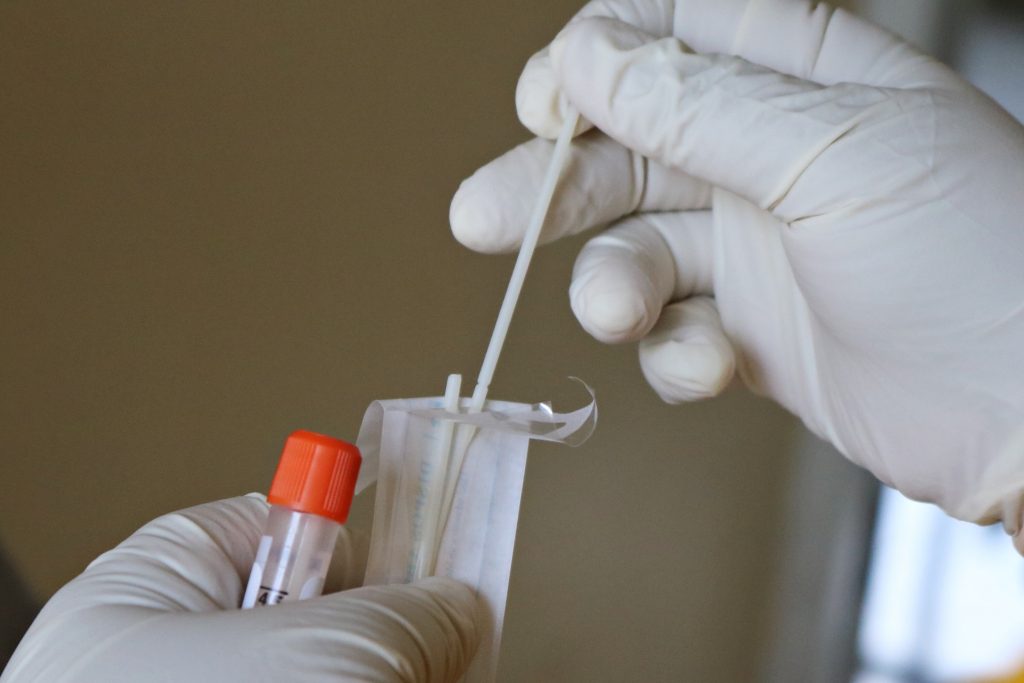Two research news from ATLAS: New Covid-19 home test under development and a new study in Nature Genetics
A new Covid-19 home test will, in just ten minutes, be able to tell whether or not you are infected. The fast test is targeting the so-called spike protein, which is the protein that binds the virus to our cells. The new test is being developed by Associate Professor Jonas Heilskov Graversen from the Center of Excellence ATLAS in collaboration with the biotech company Bioporto.

A new home test for Covid-19 is being developed by Associate Professor Jonas Heilskov Graversen from the Center of Excellence ATLAS in collaboration with the biotech company Bioporto. Once the home test is developed, it will be able to give results in just ten minutes. The fast test is targeting the so-called spike protein, which is the protein that binds the virus to our cells.
The idea behind the test is to be able to test yourself from home in a fast and effective way. The preliminary analytical studies are showing promising results, which means the researchers are optimistic about the development of the home test.
A big potential
Associate Professor Graversen has a wide expertise in antibodies. This is particularly beneficial in this study where they have to develop antibodies that selectively recognize the antigens on the virus surface. The aim is to develop a test that, based on a saliva sample, can tell patients whether or not they have Covid-19.
Given that the test will be able to give results in a matter of ten minutes, it could potentially mean that society can be reopened even more, as people would be able to know quickly whether or not they are contagious. The idea is to use the test in two ways. One way will be in large public places, e.g., in an airport. At the same time, the researchers want to develop a price-friendly home test. The researchers are aiming to get the test down to the same price group as other home tests. This way average Danes can test themselves frequently.
”This week already we have started to test it in the USA, and if everything goes well, we can send the material to healthcare systems all around the world, and hopefully bring it to the market in the first quarter of 2021,” said Peter Mørch Eriksen, the administrative director at Bioporto.
Read more about the study from ATLAS in the press release from SDU here
New study brings insight to an important function in the body in 3D
The body’s so-called enhancers control how much the different genes are expressed. In a new study a team of researchers from DNRF’s Center for Functional Genomics and Tissue Plasticity (ATLAS) at the University of Southern Denmark have taken a closer look at how the body’s enhancers interact with each other in 3D. Here they reached the conclusion that 3D enhancers communities act as key drivers of cell type-specific gene programs. The study is published in the scientific journal Nature Gentics.

In the body, you find enhancers in the regions of the DNA. These enhancers control how much different genes are expressed. Once you take a look at the interaction between them in 3D, a better understanding is reached regarding which direction cells move towards once they are developed, as well as how 3D enhancers communities act as key drivers of cell type-specific gene programs.
The new study has been published in the scientific journal Nature Gentics. A team of research from the Center of Excellence ATLAS at the University of Southern Denmark has studied enhancers. The study is led by Assistant Professor Jesper Grud Skat Madsen.
“We have studied regions in the cells genome, the DNA, that is called enhancers, which takes part in controlling how much genes are expressed. We have taken a closer look at how they interact with each other in 3D, and how this plays a part in which genes are expressed and ultimately in what direction a cell moves toward when it is developed,” said Madsen.
3D enhancers communities act as key drivers of cell type-specific gene programs
In the study a research was done in enhancers interactions on different times during the differentiation. The researches came to the conclusion that enhancers integrate signals across enhancer-to-enhancer interactions. This means that enhancers form 3D enhancer communities where many different enhancers interact with each other, as well as promoters, which too are part of the DNA region that controls genes. It is then the most highly connected enhancer communities that act as key drivers of cell type-specific gene programs.
The results from the study has important implications for the understanding of transcriptional regulation, as well as the control of cellular fate in both health and disease.
“The most important conclusion is that the expression of genes which are important for the development of cells are controlled by 3D enhancers communities. In a stem cell, you will find communities that are associated with different types of the more mature cell. One could say that in the stem cell the communities hold all the development opportunities open. When a stem cell is then stimulated to develop itself into a specific type of cell, then the communities that are associated with that cell type will be activated while the rest will be turned off,” said Madsen.
Read the scientific article in Nature Genetics here
Read more about the study from ATLAS in a press release from the University of Southern Denmark here
